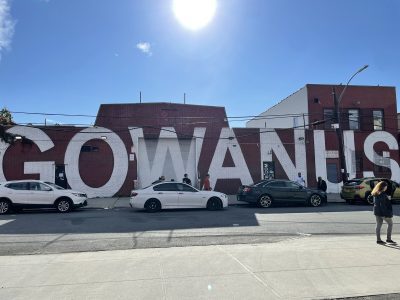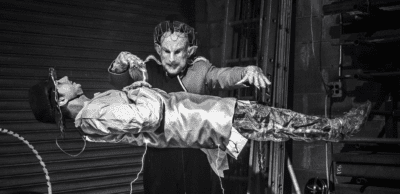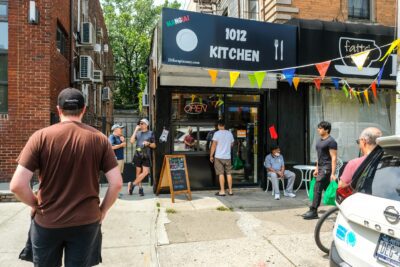Stories That Need to be Told: Strengthening LGBTQ Voices in the Arts – EV Fitzgerald
The transformative power of storytelling, in all of its forms, is no secret. But what if the stories we hear most don’t reflect the diversity of our community? And what if the stories that need to be told don’t reach those who need to hear them?
We chatted with EV Fitzgerald, member of The Yard coworking space in Gowanus, Brooklyn and creative entrepreneur within the LGBTQ community, to hear how she’s paving the way for LGBTQ voices in the arts.
EV Fitzgerald, Performer and Computer Science Teacher
EV Fitzgerald, a *non-binary trans woman, teaches computer science at a local school. When she’s not teaching, she illustrates, writes stories, and develops virtual reality projects. She also has a puppet named Illyana, who not only makes people laugh, but also isn’t scared to tell people what’s what and challenge their preconceptions.
*Editor’s note: EV goes by she, her, they, and them. For the clarity of this piece, the pronouns she/her are used.
What was your sense of community growing up?
I grew up in Las Vegas, where I went to a small private school and didn’t interact with more than sixty people for most of my life. The suburbs were really spread out around the city because of the Schelling Effect. The people who worked in the casinos filled the outskirts of the city, causing the suburbs to drift further and further out. Where I lived, I was hardly allowed to walk around. There were dirt lots and a YMCA, and that’s about it. Sometimes I was allowed to go to the skate park. That was the first time I experienced homophobia. I rollerbladed and people would be like, “Oh, you’re gay because you rollerblade”. And I was questioning this. I felt like I was a girl, but I couldn’t talk to anyone. Plus, once you did something, everyone would know about it and everyone would talk about it. It’s not a joke, it’s my identity.
And college?
My senior year of college was when I felt comfortable telling more than one person how I felt. I dressed up as a sexy cat for Halloween and loved it.
I had to ask myself, am I uncomfortable with people seeing me or uncomfortable with how I feel? It was how I felt about my body that was uncomfortable.
What creative projects do you have your hands in currently?
Well, for work-work, I’m a high school computer science teacher teaching intro to programming. Aspirationally, I want to work and have enough time to do whatever I want artistically. I’ve wanted to make comics, I’ve wanted to make movies, I’ve wanted to make video games. I kind of just get ideas and start them. I’ve been working on a lot of VR recently, which is a lot of fun.
How did you first connect with your puppet, Illyana?
Puppetry allows me to tell stories without an oppressive structure. I recently found out that when I was a kid we had a bunch of puppets, which I don’t even remember, and my mom told me I loved them. In middle school, we had a puppet theater and I remember playing with those. I always loved storytelling with puppets and with my action figures, so I guess I had a thing for animating inanimate things. I feel like video games is a form of puppetry, too; the joy of the game is moving this figure around. I learned that that’s narrative immersion – you give someone an environment and then give them a figure or puppet and they generate their own narrative.
My return to puppetry is a way to live out some fantasy or work out some thing that I want to be. I have issues with projecting myself onto other things and other people; I’d be talking to someone and agree and foster what they’re saying. Through the puppet, I can honestly project my own thoughts and desires. For example, people manspreading on the subway. I won’t say anything about it, but Illy will say, “Your legs are in my way, can you move?” Once Illyana says it, I feel more comfortable saying it, too, so I can go, “I’m going to sit there, could you please make room?”
In other instances, people might ask me if I’m a boy or a girl. Illy will be like, “That’s not a nice thing to say to someone.”
Illyana’s name comes from a character from the Marvel universe who helped me get through a lot of hard times. She’s a witch who makes portals to hell and is a victim of some traumatic stuff that she has to work through.
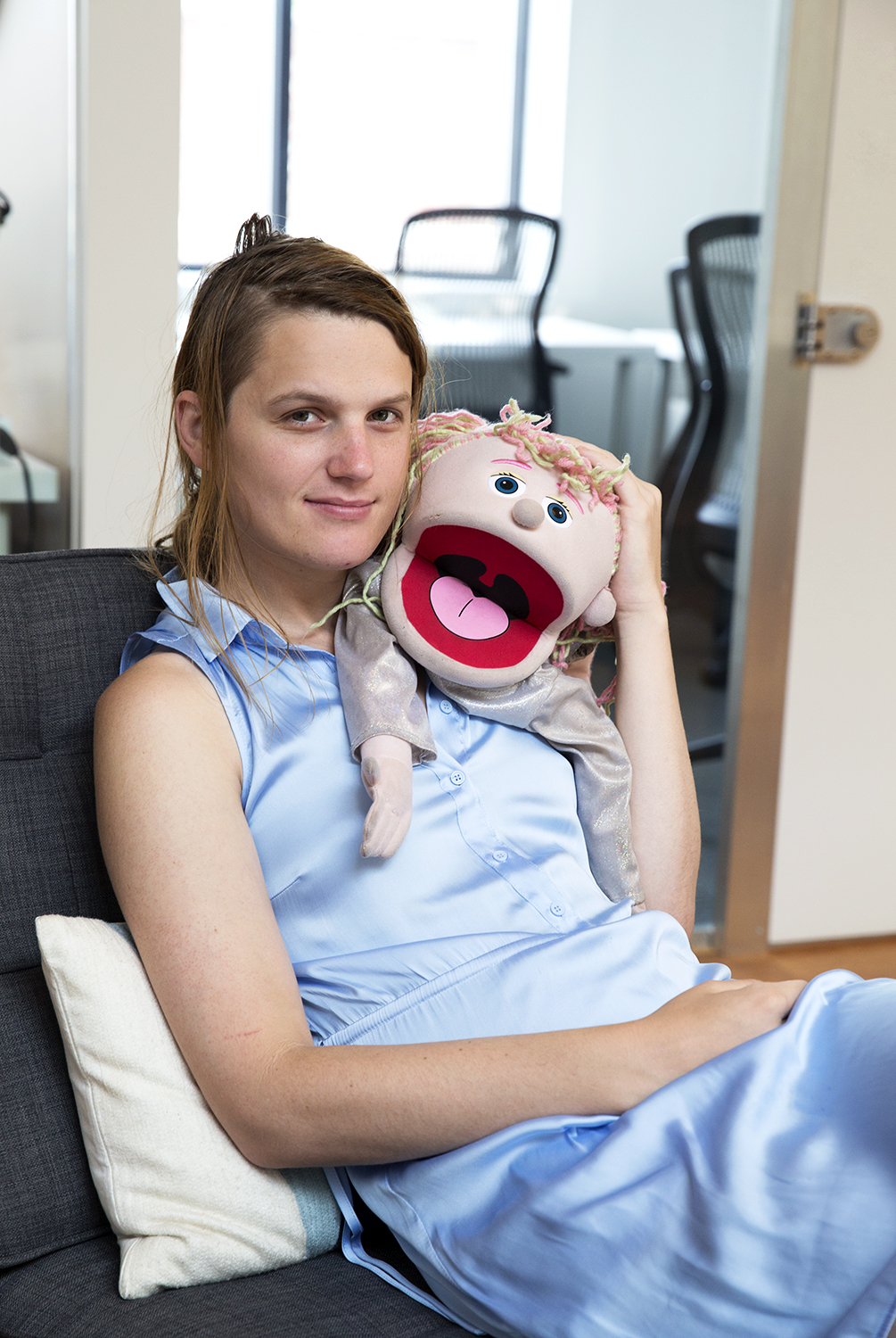
This one’s for Illyana. How do you define community and inclusivity?
Community and inclusion? Well? I’m not usually asked to think this deep. I think deep, but I usually just talk about mermaids and unicorns and fluff. Okay, yeah. It’s like being on the subway and then you’re like, “HEY!”, and someone is free to respond how they want and nobody gets mad about it.
So, EV, what brought you to Gowanus?
I like Gowanus because I heard about the monster, the Cryptid in the Gowanus Canal, and that was interesting to me. Plus, living next to Park Slope and seeing babies in strollers is relaxing. Kids aren’t exactly accepting, but they’re very critical and will call you out on things and engage with Illyana on the streets. I do other performance stuff on the streets all the time. It’s part of my queerness. Sometimes, I’ll stand on the sidewalk with hoops and play EV ring toss.
So, they would toss the hoola hoop onto you?
Yeah, nobody played that one.
How do your experiences influence your voice?
Yeah, so, I’ve been getting into astrology. My partner’s been having me read about my sign, which is Pisces. (I promise this is going to make sense). The creativity of Pisces is, like, subconscious. I hear a lot of artists that are like, I’m going to make something like this for this purpose. A lot of time for me, though, it’s after I make something that I realize that my projects are directly related to something like dysphoria or this thing that this person said to me on the train. A lot of my experiences come out in my work. Most of the time it’s not on purpose. Recently I did a piece for The Trans Theatre Festival, and the text came entirely from my dreams. It was about being out and not knowing what to do after that. I’ve written some stuff that’s intentionally reflective, too. I just wrote a piece about time traveling and talking to myself in the past.
Sometimes I’m like, I’m going to write about Ancient Greece, and then all of a sudden it’s about me. I dunno.
Can you speak on the neighborhood of Gowanus and the LGBTQ community here?
Back in March, I got to tell a story about “finding a dress that fits” in front of a bunch of people at The Yard. That was a lot of fun. I like the thrift shops here. There’s one on 13th and 5th that I really enjoy going to and everyone has a bit of a queer aesthetic. It just feels comfortable. Recently, I went to this little park and these kids started talking to me. It’s nice to be accepted by 12 year old girls when you are in your heart a 12 year old girl.
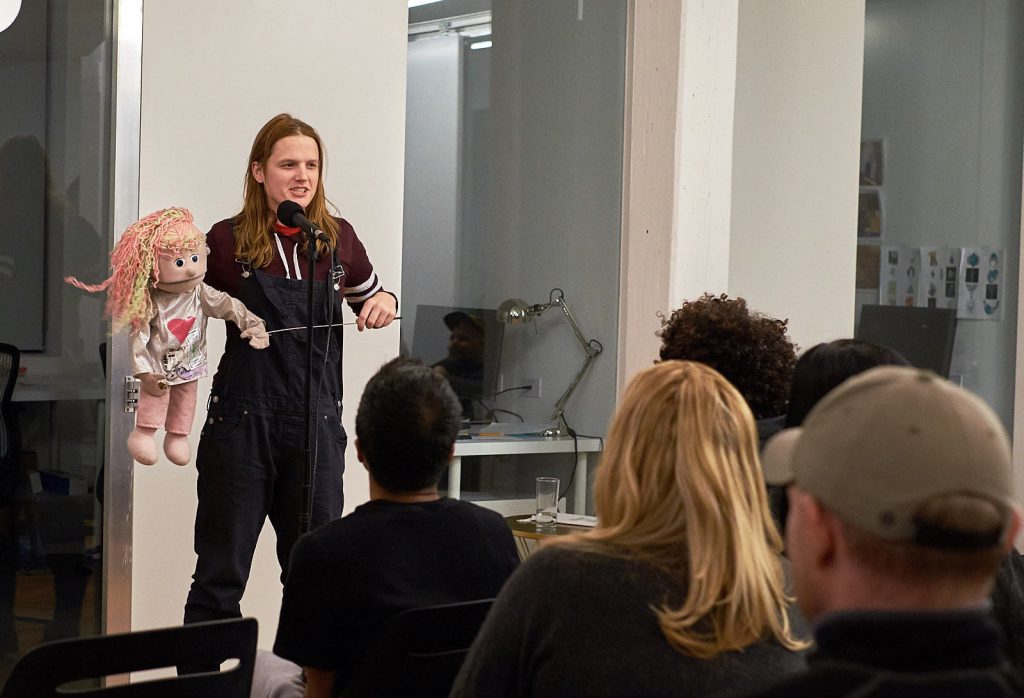

Storytelling at The Yard coworking space in Gowanus
Are there any things you’d like to see change?
I wish there were less things that were so commercial. There are a lot of people in the community who are anti-capitalist, but then you go to Brooklyn Pride and there are a bunch of people selling stuff. It’s not necessarily bad; it’s part of our culture to buy and sell things. But it would be nice to have more things where it was like, “Let’s all go meet in the park”. There are some small groups of queer folk who meet up and have conversations. Doing things like that can be difficult, because sometimes people don’t want to help themselves initially.
I wish there were more groups and things like that to help people realize, for example, how many others in the neighborhood are trans.
Anything else you want to share?
Yeah, you go through this phase of being really visible when you come out, and now I’m reaching this stage where I don’t have to be visible all the time. I’m getting to the point in my life where I’ll be able to have more of the medical stuff I want to feel comfortable and feel invisible and realizing that anyone you interact with could be within the trans community. There’s just a huge part of me that wants people to look at me and think, “Oh, that’s a girl.”
This piece is Part Two in the Stories That Need to be Told series on Strengthening LGBTQ Voices in the Arts. Check out Part One featuring Todd Coulter, Executive Director, Founder, and President of the Board at NOGO Arts.
Artwork featured in cover image by Ai Campbell.
You might also like 


















